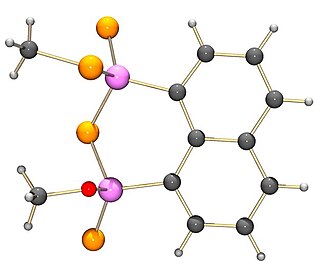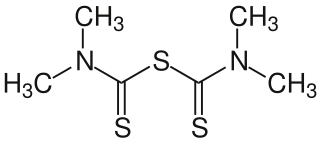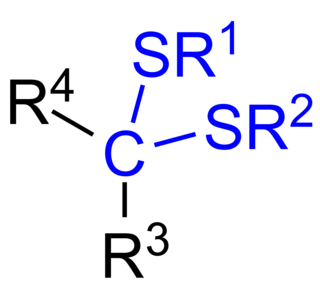 W
WS-Adenosylmethioninamine is a substrate that is involved in the biosynthesis of polyamines including spermidine, spermine, and thermospermine.
 W
WAmmonium bituminosulfonate or ammonium bituminosulphonate is a product of natural origin obtained in the first step by dry distillation of sulfur-rich oil shale. By sulfonation of the resulting oil, and subsequent neutralization with ammonia, Ichthammol results as a viscous, water-soluble substance with a characteristic bitumen-like odor. It is used in medicine as a treatment for different skin diseases, including eczema and psoriasis. Ointments containing 10% or 20% Ichthammol are most common. They are sometimes called "black ointments" or "drawing salves". Ichthammol's dermatological action was promoted by German physician Paul Gerson Unna.
 W
WAurothioglucose, also known as gold thioglucose, is a chemical compound with the formula AuSC6H11O5. This derivative of the sugar glucose was formerly used to treat rheumatoid arthritis.
 W
WIn organosulfur chemistry, a Bunte salt is an archaic name for salts with the formula RSSO3–Na+. They are also called S-alkylthiosulfates or S-arylthiosulfates. These compounds are typically derived from alkylation on the pendant sulfur of sodium thiosulfate:RX + Na2S2O3 → Na[O3S2R] + NaX
 W
WCarbosulfan is an organic compound adherent to the carbamate class. At normal conditions, it is brown viscous liquid. It is not very stable; it decomposes slowly at room temperature. Its solubility in water is low but it is miscible with xylene, hexane, chloroform, dichloromethane, methanol and acetone. Carbosulfan is used as an insecticide. The European Union banned use of carbosulfan in 2007.
 W
WChloro(dimethyl sulfide)gold(I) is a coordination complex of gold. It is a white solid. This compound is a common entry point into gold chemistry.
 W
WDiethylaminosulfur trifluoride (DAST) is the organosulfur compound with the formula Et2NSF3. This liquid is a fluorinating reagent used for the synthesis of organofluorine compounds. The compound is colourless; older samples assume an orange colour.
 W
WDimethyl trisulfide (DMTS) is an organic chemical compound and the simplest organic trisulfide. It is a flammable liquid with a foul odor, which is detectable at levels as low as 1 part per trillion.
 W
WDithiete is an unsaturated heterocyclic compound that contains two adjacent sulfur atoms and two sp2-hybridized carbon centers. Derivatives are known collectively as dithietes or 1,2-dithietes. With 6 π electrons, 1,2-dithietes are examples of aromatic organosulfur compounds. A few 1,2-dithietes have been isolated.
 W
WDithiin is a class of heterocyclic compounds, with the parent members having the formula (C2H2)2S2. Two isomers of this parent are recognized, 1,2- and 1,4-dithiins. Planar dithiins are 8π e− systems and thus antiaromatic. Akin to the behavior of cyclooctatetraene adopts nonplanar structures. Vinyldithiin, a common component of garlic, is a misnomer for 3-vinyl-4H-1,2-dithiin. 1,3-dithiins are unknown.
 W
WDithiobenzoic acid is the organosulfur compound with the formula C6H5CS2H. It is a dithiocarboxylic acid, an analogue of benzoic acid, but more acidic and deeply colored.
 W
WA dithiol is a type of organosulfur compound with two thiol functional groups. Their properties are generally similar to those of monothiols in terms of solubility, odor, and volatility. They can be classified according to the relative location of the two thiol group on the organic backbone.
 W
WDithiolium salts are compounds of the formula [(RC)3S2]+X− (R = H, alkyl, aryl, etc.). These salts consist of a planar organic cation with a variety of anions such as halides. The five-membered ring cations are observed in either of two isomers, 1,2- and 1,3-dithiolium cations. These cations differ with respect to the relative positions of the pair of sulfur atoms. Both isomers feature a planar ring, which is aromatic owing to the presence of 6π electrons. For example, the 1,2-ditholium ring can be represented as an allyl cation of the three carbons, with each sulfur atom donating one of its lone pairs of electrons to give a total of three pairs.
 W
WHemithioacetal is an organic functional group with the general formula RCH(OH)SR. Hemithioacetals are also called thiohemiacetal. With four substituents on carbon, hemithioacetals are chiral. A related functional group is dithiohemiacetal, with the formula RCH(SH)SR. Although they can be important intermediates, hemithioacetals are usually not isolated since they exist in equilibrium with the thiol and aldehyde.
 W
W6β-Hydroxy-7α-thiomethylspironolactone (6β-OH-7α-TMS) is a steroidal antimineralocorticoid of the spirolactone group and a major active metabolite of spironolactone. Other important metabolites of spironolactone include 7α-thiospironolactone, 7α-thiomethylspironolactone, and canrenone (SC-9376).
 W
WIsopropyl β-d-1-thiogalactopyranoside (IPTG) is a molecular biology reagent. This compound is a molecular mimic of allolactose, a lactose metabolite that triggers transcription of the lac operon, and it is therefore used to induce protein expression where the gene is under the control of the lac operator.
 W
WMelarsomine (melaminylthioarsenate) is a trypanocidal agent. In the U.S., it is marketed under the trade names Immiticide (Merial) and Diroban (Zoetis), and is approved by the FDA's Center for Veterinary Medicine for the treatment of adult heartworm infection in dogs. It is not approved for treatment in cats, or dogs in late-stage infection.
 W
WA compound related to Lawesson's reagent named NpP2S4 has been formed by the reaction of 1-bromonaphthalene with P4S10, this is a 1,3,2,4-dithiadiphosphetane 2,4-disulfide which has a naphth-1,8-diyl group holding the two phosphorus atoms together. The mechanism by which the NpP2S4 forms is unclear, but it is thought to occur through some free radical process, and naphthalene has been detected as a side product in its synthesis. In general NpP2S4 has been found to be less reactive than Lawesson's reagent, this result agrees with the hypothesis that the dithiophosphine ylides are responsible for the majority of the chemical reactions of the 1,3,2,4-dithiadiphosphetane 2,4-disulfides.
 W
WPentafluorosulfanylbenzene, also known as phenylsulfur pentafluoride, is an organosulfur compound with the formula C6H5SF5. It is colorless liquid with high chemical stability.
 W
WPerchloromethyl mercaptan is the organosulfur compound with the formula CCl3SCl. It is mainly used as an intermediate for the synthesis of dyes and fungicides (captan, folpet). It is a colorless oil, although commercial samples are yellowish. It is insoluble in water but soluble in organic solvents. It has a foul, unbearable, acrid odor. Perchloromethyl mercaptan is the original name. The systematic name is trichloromethanesulfenyl chloride, because the compound is a sulfenyl chloride, not a mercaptan.
 W
WPhorate is an organophosphate used as an insecticide and acaricide.
 W
WPotassium thioacetate is an organosulfur compound and a salt with the formula CH3COS−K+. This white, water-soluble solid is used as a reagent for preparing thioacetate esters and other derivatives.
 W
W2,6-Pyridinedicarbothioic acid (PDTC) is an organosulfur compound that is produced by some bacteria. It functions as a siderophore, a small chelating agent with a high affinity for iron. Siderophores are deployed as ion scavengers for microbes. Siderophores solubilize compounds by forming strong complexes. PDTC is secreted by the soil bacteria Pseudomonas stutzeri and Pseudomonas putida.
 W
WRo 6-3129, also known as 16α-ethylthio-6-dehydroretroprogesterone or as 16α-ethylthio-9β,10α-pregna-4,6-diene-3,20-dione, as well as 16α-ethylthiodydrogesterone, is a progestogen of the retroprogesterone group which was developed by Roche but was never marketed. It shows greater potency than dydrogesterone in bioassays.
 W
WRU-56187 is a nonsteroidal antiandrogen which was never marketed. It shows 92% of the affinity of testosterone for the androgen receptor and negligible affinity for other steroid hormone receptors. The medication is a silent antagonist of the androgen receptor. RU-56187 is 3- to 10-fold more potent as an antiandrogen than bicalutamide or nilutamide in animals. Both RU-56187 and RU-58841 appear to be prodrugs of cyanonilutamide (RU-56279) in vivo in animals.
 W
WRU-57073 is a nonsteroidal antiandrogen which was never marketed. It shows 163% of the affinity of testosterone for the androgen receptor and negligible affinity for other steroid hormone receptors.
 W
WSulfene is an extremely reactive chemical compound with the formula H2C=SO2. It is the simplest member of the sulfenes, the group of compounds which are S,S-dioxides of thioaldehydes and thioketones, and have the general formula R2C=SO2.
 W
WA sulfenic acid is an organosulfur compound and oxoacid with the general formula RSOH. It is the first member of the family of organosulfur oxoacids, which also include sulfinic acids and sulfonic acids, RSO2H and RSO3H, respectively. The base member of the sulfenic acid series with R = H is hydrogen thioperoxide.
 W
WA sulfenyl chloride is a functional group with the connectivity R–S–Cl, where R is alkyl or aryl. Sulfenyl chlorides are reactive compounds that behave as sources of RS+. They are used in the formation of RS–N and RS–O bonds. According to IUPAC nomenclature they are named as alkyl thiohypochlorites, i.e. esters of thiohypochlorous acid.
 W
WSulfinylmethane or sulfine is an organic compound with molecular formula H2CSO. It is the simplest sulfine. Sulfines are chemical compounds with the general structure XY=SO. IUPAC considers the term 'sulfine' obsolete, preferring instead thiocarbonyl S-oxide, despite this the use of the term sulfine still predominates in the chemical literature.
 W
WSulfinyl halide groups occur when a sulfinyl functional group is singly bonded to a halogen atom. They have the general formula R-S(O)-X, where X is a halogen, and are intermediate in oxidation level between sulfenyl halides, R-S-X, and sulfonyl halides, R-SO2-X. The best known examples are sulfinyl chlorides, thermolabile, moisture-sensitive compounds, which are useful intermediates for preparation of other sufinyl derivatives such as sulfinamides, sulfinates, sulfoxides and thiosulfinates. Unlike the sulfur atom in sulfonyl halides and sulfenyl halides, the sulfur atom in sulfinyl halides is chiral, as shown for methanesulfinyl chloride.
 W
WA sulfonyl group can refer either to a functional group found primarily in sulfones or to a substituent obtained from a sulfonic acid by the removal of the hydroxyl group similarly to acyl groups. Sulfonyl groups can be written as having the general formula R−S(=O)2−R′, where there are two double bonds between the sulfur and oxygen.
 W
Wsyn-Propanethial S-oxide (C3H6OS), a member of a class of organosulfur compounds known as thiocarbonyl S-oxides (formerly "sulfines"), is a volatile liquid that acts as a lachrymatory agent (triggers tearing and stinging on contact with the eyes). The chemical is released from onions, Allium cepa, as they are sliced. The release is due to the breaking open of the onion cells and their releasing enzymes called alliinases, which then break down amino acid sulfoxides, generating sulfenic acids. A specific sulfenic acid, 1-propenesulfenic acid, formed when onions are cut, is rapidly rearranged by a second enzyme, called the lachrymatory factor synthase or LFS, giving syn-propanethial S-oxide. The gas diffuses through the air and, on contact with the eye, it stimulates sensory neurons creating a stinging, painful sensation. Tears are released from the tear glands to dilute and flush out the irritant. A structurally related lachrymatory compound, syn-butanethial S-oxide, C4H8OS, has been found in another genus Allium plant, Allium siculum.
 W
WTetramethylthiuram sulfide is an organosulfur compound with the formula ((CH3)2NCS)2S. It is a yellow solid that is soluble in organic solvents. It is the parent member of a large class of tetraalkylthiuram sulfides. It is used as an activator in the sulfur vulcanization of natural and butyl rubbers.
 W
WThioacetic acid is an organosulfur compound with the molecular formula CH3COSH. It is a yellow liquid with a strong thiol-like odor. It is used in organic synthesis for the introduction of thiol groups in molecules.
 W
WThioindigo is an organosulfur compound that is used to dye polyester fabric. A synthetic dye, thioindigo is related to the plant-derived dye indigo, replacing two NH groups with two sulfur atoms.
 W
WIn chemistry, a thioketal is the sulfur analogue of a ketal, with one of the oxygen replaced by sulfur. A dithioketal has both oxygens replaced by sulfur.
 W
WA thiol or thiol derivative is any organosulfur compound of the form R−SH, where R represents an alkyl or other organic substituent. The –SH functional group itself is referred to as either a thiol group or a sulfhydryl group, or a sulfanyl group. Thiols are the sulfur analogue of alcohols, and the word is a portmanteau of "thio-" + "alcohol", with the first word deriving from Greek θεῖον (theion) meaning "sulfur".
 W
W7α-Thiomethylspironolactone is a steroidal antimineralocorticoid and antiandrogen of the spirolactone group and the major active metabolite of spironolactone. Other important metabolites of spironolactone include 7α-thiospironolactone, 6β-hydroxy-7α-thiomethylspironolactone (6β-OH-7α-TMS), and canrenone (SC-9376).
 W
W7α-Thioprogesterone is a synthetic, steroidal, and potent antimineralocorticoid (putative) and antiandrogen which was developed by G. D. Searle & Co and was described in the late 1970s and early 1980s but was never developed or introduced for medical use. It is a derivative of progesterone (pregn-4-ene-3,20-dione) with a thio (sulfur) substitution at the C7α position, and is related to the spirolactone group of drugs but lacks a γ-lactone ring.
 W
WA thioselenide is any organic chemical compound containing a selenium-sulfur bond.
 W
W7α-Thiospironolactone is a steroidal antimineralocorticoid and antiandrogen of the spirolactone group and a minor active metabolite of spironolactone. Other important metabolites of spironolactone include 7α-thiomethylspironolactone, 6β-hydroxy-7α-thiomethylspironolactone (6β-OH-7α-TMS), and canrenone (SC-9376).
 W
WThiosulfonates are organosulfur compounds with the formula RSO2SR'. Thiosulfonate esters are produced by oxidation of disulfides or by the reaction or organosulfonyl halides with thiolates.
 W
WTipredane is a synthetic glucocorticoid corticosteroid which was never marketed.
 W
WTrifluoromethanesulfonyl azide or triflyl azide is an organic azide used as a reagent in organic synthesis.
 W
WTrimethylsulfoxonium iodide is a sulfoxonium salt. It is used to generate dimethyloxosulfonium methylide by reaction with sodium hydride. The latter compound is used as a methylene-transfer reagent, and is used to prepare epoxides.